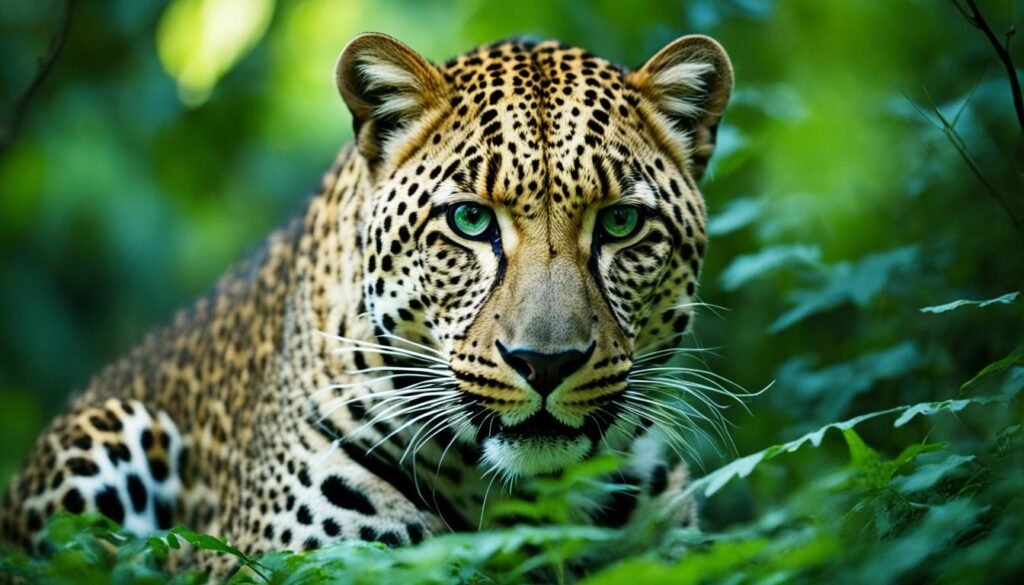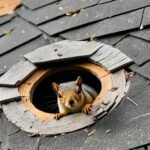Small predatory animals include weasels, martens, and mongooses. Despite their size, they are skilled at hunting prey. They live in many places, from grasslands to cities, and use different tactics to catch their food.
These carnivorous mammals and reptiles are important. They help keep the number of rodents, birds, and small animals in check. They do this through their unique and effective hunting behaviors.
Predation is crucial for the health of ecosystems. It plays a big role in keeping the natural world in balance. Predators focus on weaker or less experienced animals, ensuring that the strongest survive. This includes birds and eagles that soar through the air to catch their meals. There are also reptiles like alligators that hunt in water and on land. Don’t forget insects, such as spiders, which skillfully trap their prey in webs.
Nature’s Apex Predators
The African wild dogs, black-footed cats, and cheetahs are top predators with amazing skills. They’ve developed these over time to catch their prey efficiently. Even with fierce competition, these animals excel due to their unique adaptations in their habitats.
African Wild Dogs: Highly Successful Hunters
African wild dogs are super successful at hunting, getting their prey in over 85% of chases. They are slim and have big ears, showing their incredible hunting skills. They are unique, not like wolves or domestic dogs, making them fascinating among predators.
Black-Footed Cats: Nocturnal Hunting Machines
Black-footed cats are small but mighty hunters, especially at night. They’re very good at catching their prey, with a kill rate above 60% in certain studies. Their exceptional night vision, stealth, and speed help them take down various small animals.
Cheetahs: Pursuit Specialists
Cheetahs are famous for their speed, making them unmatched when it comes to chasing prey. They catch their prey about 50% of the time but can run very fast for short distances. With speeds up to 75 mph, they dominate the open lands of the Serengeti.
The Elusive Leopard

Leopards are known for being hard to see in Africa. They’re smart hunters and can blend into their surroundings well. Research shows that how successful they are in catching prey varies. In northeast Namibia, leopards catch their prey 38% of the time. But in the Kalahari area, this drops to 14%.
Interestingly, male and female leopards hunt differently. Mothers looking after cubs have a 28% success rate. Yet, solitary males only succeed 14% of the time.
Hunting Success Rates of Leopards
Leopard hunting success varies for several reasons. The place they live, the food around, and how they hunt all play a role. Unlike some big cats, leopards prefer to go it alone. This, plus their ability to disappear in plain sight, makes them great at catching prey by surprise.
Solitary and Group Hunting Strategies
Most often, leopards prefer to hunt by themselves. But sometimes, they team up, especially when dealing with a tough prey. Even so, hunting together is not their best tactic. They usually catch food better when alone, using their stealth and ambush tactics.
Domestic Cats: Backyard Predators
Domestic cats are dear to many, but they are also major players in affecting local wildlife. Through a study tracking over 900 cats, it was shown that the kills they make in small areas are significant. They bring home about 11 dead animals a month, but they only eat about a third of their prey.
Impact on Local Wildlife Populations
Cats, whether they’re feral or owned, kill millions of birds and small animals each year. One research noted that domestic and feral cats take out billions of birds annually. In the US, outdoor cats might be causing between 1.3 and 4.0 billion bird deaths yearly. Around 69% of these casualties come from un-owned cats.
When it comes to mammals, cats could be causing between 6.3 and 22.3 billion deaths. The major part, about 89%, is due to un-owned cats. This shows the heavy toll outdoor cats take on wildlife.
Managing Outdoor Cats
To limit the harm from outdoor cats, experts suggest several actions. Always keeping cats indoors, and using deterrences can greatly benefit. Carefully monitoring their time outside can also help a lot.
One study found that brightly colored collars can significantly cut down the birds cats catch. So, by adopting these recommendations, we can help protect local ecosystems and keep our wildlife thriving.
Lions: The King of the Jungle

Lions rule over the African savannah, known as the apex predator. Their hunting success depends a lot on their numbers. A lone lion successfully catches its prey only 17-19% of the time. Yet, when lions hunt as a group, their success jumps up to 30%.
In the Serengeti, researchers observed over 1,300 hunts. Almost half those hunts were done by a single lion. About 20% included two lions. The rest, from three to eight lions, worked together.
Hunting Success Rates of Lions
Group hunting greatly improves a lion’s chance of making a kill. A group of lions, known as a pride, achieves a success rate of up to 30% during their hunts. When lions hunt alone, their chances of catching prey drop to 17-19%.
Subspecies of Lions
Lions fall under one species, Panthera leo, with two known subspecies. These are the African lion (P. l. leo) and the Asiatic lion (P. l. persica). Some scholars have suggested a different categorization.
They propose that P. l. leo, should cover lions in Asia and parts of Africa. Then, P. l. melanochaita should be used for lions in the southern and eastern regions of Africa.
The lion, especially the Asiatic kind, carries a deep cultural and symbolic meaning in certain nations. These include countries like India, the Netherlands, Ethiopia, the UK, and Sri Lanka. There, lions are seen as crucial national animals. They are symbols of pride and national identity.
Wolves: The Pack Hunters
Wolves are known for their skill in hunting together as a pack. They use teamwork to catch animals for food. But, how often they catch their prey can change a lot. This depends on what animals they’re hunting and the place they’re in.
Hunting Success Rates of Wolves
Research shows that wolves don’t always catch their prey. Studies found they succeed about 14% of the time when hunting. But, this success rate varies widely. For example, wolves hunting moose in the US were only successful 6% of the time. Yet, in Minnesota, when chasing white-tailed deer, they were successful about 20% of the time. This shows how different prey and surroundings affect their hunting success.
Wolves work as a team when hunting. Not all members of the pack directly attack the prey. Female wolves that are quick and agile often lead the hunt. They run in front of the prey to cause confusion. This allows the slower, stronger male wolves to make the catch.
Wolves don’t kill their prey fast. Their victims usually die from shock, injury, or loss of blood. Sometimes, stronger pack members help speed things up by holding the prey down. Despite how challenging hunting is for wolves, it’s an impressive team effort. They work together in a way that’s worth recognizing.
Polar Bears: Ice Warriors
Polar bears are the kings of the Arctic. They’ve evolved amazing hunting skills over time. Living in a world of ice, these huge, white bears mostly eat seals. They catch seals by sneaking up on them or finding seals in the water.
Studies show they catch their prey about 1 out of 10 tries. This shows how well they’ve adapted in their icy home.
Hunting Strategies of Polar Bears
Polar bears can smell seals from miles away. Their big, soft paws help them walk quietly on ice. They wait near spots where seals come up for air or rest.
Some bears have been seen hunting other animals. This includes reindeer and even whales. They do this by waiting near the places where these animals might appear.
Climate Change and Polar Bear Survival
The polar bear’s future looks grim because of global warming. The loss of Arctic ice is a major problem. Less ice means it’s harder for them to find food. This leads to fewer baby bears being born and more bears dying.
Polar bears need the ice to hunt seals, their main food. With the ice disappearing, these bears are in trouble. There are about 22,000 bears left in the wild. They’re in danger because of climate change.
Tigers: Solitary Stalkers
Tigers are known for how they hunt solo, pacing through the wilderness with great care. In Kanha National Park, only a small number of hunts were successful, around 5-10%. But, up in Russia’s Far East, Amur tigers did better. They were successful in 38% of their hunts for red deer and 54% when targeting wild boar.
These big cats are skilled at stalking, waiting to strike with agility. They use their stripes as a hidden advantage while they wait. Unlike some big hunters who team up, tigers prefer to be independent hunters.
Tigers around the world are facing a critical problem. The number of tigers has dropped by 97% since the 1900s. Main reasons include losing their homes, the breaking up of their living areas, and hunting by people. Now, just five types of tigers are left, making them an Endangered species.
Groups like Wildlife SOS are working hard to protect the tigers we have left. Their efforts are key to stopping the dangers these big cats face.
Small Predatory Animals

The world of small predators is rich with hunters that are unique in their own way. In this group, the least weasel (Mustela nivalis) shines as the tiniest carnivore. It may be small, but this little weasel is fierce. It can eat up to half its weight in small rodents every night.
Least Weasels: The World’s Smallest Carnivores
At under two ounces, the least weasel shows off nature’s creativity with small predators. In Ohio, they’re not uncommon but hard to see. They hide well and are active at night. Even in their small size, they are efficient hunters. They have sharp senses, act quickly, and are always on the prowl.
Weasel Family Members in Ohio
Ohio is a home to many weasel family members too, like the short-tailed weasel (ermine) and the long-tailed weasel. Also, American mink, American badger, and northern river otter live there. The fisher, part of this family, is coming back to Ohio. These animals are key in keeping the environment in balance by managing other animal populations.
Semi-Aquatic Predators
Beavers, muskrats, and other semi-aquatic mammals are common in North America’s waterways. They use many ways to hunt their prey in the water.
Beavers: Dam Builders and Ecosystem Engineers
Beavers are well-known for building dams. A beaver can weigh up to 50 pounds and uses its teeth to cut trees. These dams they build make homes for many other animals.
Muskrats: Mistaken for Beavers
Muskrats look like small beavers but don’t have the same tail shape. They are found in marshes and slow-moving water, unlike beavers.
Nutrias: Invasive Aquatic Rodents
Nutrias are bigger than muskrats but smaller than beavers. They cause harm in certain areas by eating a lot and digging.
Minks: Weasel-like Hunters
Minks, part of the weasel family, hunt near water. They are good at swimming and catching their prey in the water.
River Otters: Playful Predators
River otters are fun to watch and known for playing in the water. They are skillful at catching their food using their whiskers and feet.
Water Shrews and Water Voles
Water shrews and voles are not often seen. They stay hidden in the water’s edge but are strong swimmers. The water vole is large and known for its big back feet.
Misidentification Challenges
It’s not easy to tell semi-aquatic mammals apart. Many look alike and act in similar ways. Using a good field guide and watching for special physical traits is key. This helps us know the difference between beavers, muskrats, and nutrias.
Key Identifying Features
Looking closely at their tail shape, size, and body shape is important. This helps people who love nature and scientists tell these animals apart. Knowing the small differences is vital for enjoying wildlife watching and for saving them through conservation efforts.
Behavioral Cues for Identification
Watching how these animals act is also crucial. Their feeding habits, swimming styles, and den building tell us a lot. It prevents common mix-ups, like thinking a muskrat is a small beaver. It helps us truly understand these cool semi-aquatic mammals.
Conclusion
From tiny least weasels to big lions, small predatory animals are crucial for nature’s harmony. Even though they are small, these predators have unique skills and tactics to get their food. This includes creatures like the efficient African wild dogs and the more reserved tigers.
Knowing about the hunting behaviors of these predators and their role in the environment is key for saving them. It’s also essential for correctly identifying and valuing wildlife. As we study and watch these animals, we learn a lot about nature’s delicate balance.
The ecosystems in places like Whitebridge, full of nature reserves and conservation zones, show us why we must protect these creatures. Their habitats are crucial to preserve our natural world. With more research, teaching, and efforts to save these animals, we help Earth’s life keep thriving. Small predators have a big impact on the environment, and by understanding this, we can better care for our planet.
FAQ
What are small predatory animals and what role do they play in ecosystems?
Animals like weasels, martens, and mongooses are nature’s tiny hunters. They are key to keeping ecosystems in balance. Despite being small, these animals use many ways to hunt and control the numbers of their prey.
What is the hunting success rate of African wild dogs?
African wild dogs are very good hunters. They succeed in over 85% of their chases. However, they might lose some kills to other wild animals, like hyenas. They are sleek and skilled hunters with high success rates.
How do leopards’ hunting success rates compare between genders and hunting strategies?
Leopard studies show a big difference between males and females in hunting. Females with cubs are more successful, with a 28% kill rate. Males hunting alone have only a 14% success rate. Leopards mainly hunt on their own, using stealth and surprise to catch prey.
What is the impact of domestic cats on local wildlife populations?
Domestic cats, whether feral or pets, harm wildlife significantly. They kill millions of smaller animals each year. In northern Australia, feral cats had a 32% success rate in hunting. However, they didn’t always eat their kills.
How does the hunting success rate of lions vary based on the number of individuals involved?
Lions’ hunting success changes with the size of the hunting party. A single lion hunting has a 17-19% success rate. When they hunt together, this rate jumps to 30%. In the Serengeti, most hunts are done by single lions with mixed results.
What is the average hunting success rate for wolves, and how does it vary based on prey species and environmental conditions?
Wolves have an average success rate of 14% when hunting. This rate can change depending on the prey and the location. For example, hunting moose, they were only successful 6% of the time. Yet, they killed white-tailed deer about 20% of their hunts. Their hunting success also depends on their pack strategies.
How do polar bears hunt, and how is climate change affecting their survival?
Polar bears hunt seals in the icy regions. Their hunting success is only about 10%. Climate change is lowering sea ice levels, which affects the bears. Fewer cubs survive as their hunting grounds diminish. This poses a major risk to their future.
What is the hunting success rate of tigers, and how does it vary based on the habitat?
In India’s Kanha National Park, tigers succeed in hunting only 5-10% of the time. Yet, Amur tigers in Russia do better, killing 38% of red deer and 54% of wild boar they chase. Forest tigers are great at stalking and surprise, ensuring their success.
What are some examples of small predatory animals, and which weasel species are found in Ohio?
The least weasel is the tiniest predator at just under two ounces. It is still fierce. Ohio also hosts the short-tailed weasel, long-tailed weasel, American mink, American badger, and northern river otter. The fisher was once gone from Ohio but is now coming back.
What are some examples of semi-aquatic predators, and what challenges are there in identifying them?
North America has semi-aquatic predators like beavers, muskrats, nutrias, and others. It can be hard to tell them apart. A good guide and noting their tail and body shape can help. Observing their habits is useful too.













